Top 7 Blockchain Programming Languages to Learn in 2025

The world of decentralized applications (dApps) and Web3 is expanding at a breakneck pace, with the demand for skilled developers skyrocketing. At the core of this revolution are blockchain programming languages, specialized tools for building secure, transparent, and immutable systems. But with a growing list of options like Solidity for Ethereum and Rust for Solana, choosing where to focus your learning can be daunting.
Are you aiming to build the next big DeFi protocol, a cutting-edge NFT marketplace, or something entirely new? This guide breaks down the top blockchain programming languages, detailing their unique features, primary use cases, and the platforms they power. We provide a clear roadmap to navigate this complex landscape, helping you select the right language to match your ambition and start building the future of the internet.
For those looking to accelerate their journey, tools like Dreamspace, a vibe coding studio and AI app generator, can help bridge the gap from idea to a live on-chain application, even without deep coding expertise. We will explore the essential languages behind smart contracts, decentralized finance, and Web3 infrastructure, ensuring you have the knowledge to succeed. This article is your direct path to understanding which language fits your project goals.
1. Solidity: The King of Ethereum and EVM-Compatible Chains
Solidity is the undisputed leader among blockchain programming languages, primarily because it powers Ethereum, the world's largest smart contract platform. Its syntax, heavily influenced by C++, Python, and JavaScript, offers a familiar entry point for millions of web developers, lowering the initial barrier to blockchain development. Designed specifically to target the Ethereum Virtual Machine (EVM), Solidity is the go-to language for creating the complex logic behind decentralized applications (dApps), non-fungible tokens (NFTs), and decentralized finance (DeFi) protocols.

Its dominance extends beyond Ethereum to a vast ecosystem of EVM-compatible chains, including Polygon, Avalanche, and Binance Smart Chain. This cross-chain compatibility means developers can write code once and deploy it across multiple networks, significantly expanding their application's reach. As an object-oriented, statically-typed language, it enforces type checks at compile time, a critical feature for building secure and predictable financial contracts where even minor bugs can lead to catastrophic losses.
Key Features and Developer Experience
The true power of Solidity lies in its mature and extensive ecosystem. Developers have access to a rich suite of tools that streamline the entire development lifecycle:
- Development Frameworks: Tools like Truffle and Hardhat provide environments for compiling, testing, and deploying smart contracts.
- IDE Integration: The Remix IDE is a browser-based compiler and runtime environment, perfect for learning and rapid prototyping without any local setup.
- Community and Resources: The massive developer community has produced countless tutorials, libraries (like OpenZeppelin for secure contract standards), and forums, ensuring you can find help for almost any problem.
For those looking to build dApps with less code, platforms like Dreamspace, an innovative AI app generator, can help scaffold projects, bridging the gap between complex Solidity logic and user-friendly front-ends. This ecosystem support is a key differentiator, making Solidity not just a language but a comprehensive development platform.
Key Insight: While newer languages offer performance improvements, Solidity's network effect is its greatest advantage. The vast pool of audited code, developer talent, and battle-tested infrastructure on EVM chains provides a level of security and reliability that is hard to match.
Getting Started with Solidity
Accessing Solidity is completely free. The official documentation at soliditylang.org is the best place to start. Newcomers should focus on understanding the core concepts of the EVM, such as gas fees, the memory model, and contract ownership. A common pitfall for new developers is underestimating security; it is crucial to study known attack vectors like reentrancy and integer overflow and to adopt best practices from the start.
Website: https://soliditylang.org/
2. Coursera: Structured University-Led Blockchain Education
Coursera provides a structured and academic pathway for developers looking to master blockchain programming languages. By collaborating with leading universities and tech companies like the University at Buffalo, INSEAD, and IBM, it offers a catalog of courses and specializations that cover everything from foundational blockchain theory to advanced smart contract development. This makes it an ideal platform for those who prefer a guided curriculum over self-directed learning, providing a clear roadmap from beginner to proficient.
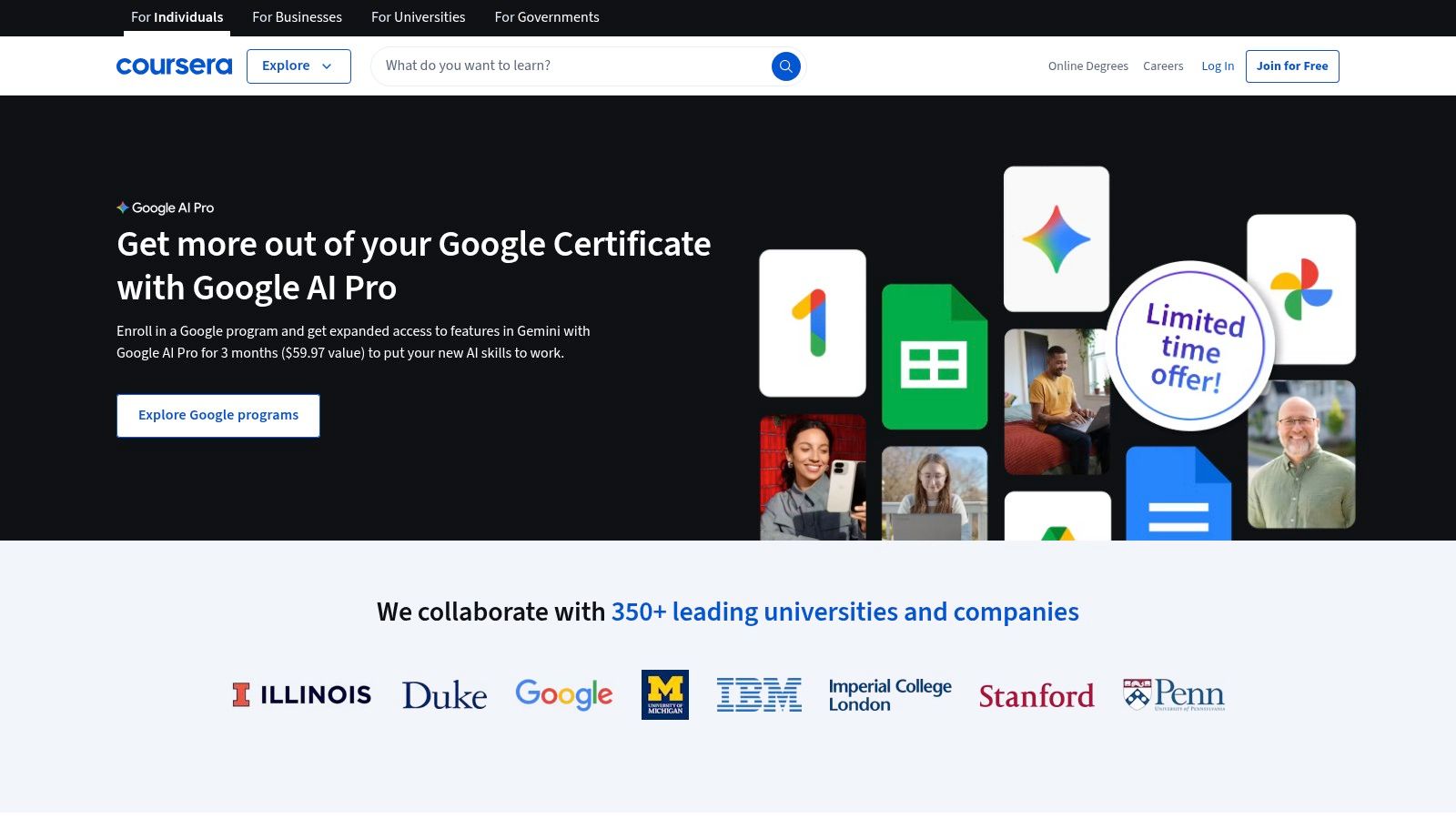
Unlike simply reading documentation, Coursera’s courses immerse you in a comprehensive learning experience with video lectures, readings, and peer-reviewed assignments. This approach is particularly effective for understanding the complex logic of languages like Solidity or Rust within the context of real-world applications. The platform bridges the gap between theoretical knowledge and practical skill, preparing developers to build secure and efficient decentralized solutions.
Key Features and Developer Experience
Coursera’s strength lies in its high-quality, university-vetted content and flexible learning model. It provides a formal educational environment that many developers find invaluable for mastering complex technical subjects.
- Institutional Backing: Courses are created and taught by professors and industry experts from top-tier institutions, ensuring a high standard of educational content.
- Flexible Learning: Learners can audit most courses for free to access video lectures and reading materials. The paid track unlocks graded assignments, projects, and a shareable certificate upon completion.
- Hands-On Projects: Many specializations include capstone projects where you build a portfolio piece, such as your own dApp or a private blockchain.
- Community Interaction: Active discussion forums for each course allow learners to ask questions and collaborate with a global community of peers.
For developers who learn best with structure, Coursera is exceptional. After grasping the core concepts, you can use tools like Dreamspace, a vibe coding studio, to rapidly apply your new skills, turning complex blockchain logic into functional applications with greater speed.
Key Insight: Coursera is the best choice for developers seeking credentials and a formal education in blockchain. The verified certificates from renowned universities can add significant weight to a resume, demonstrating a committed and structured approach to learning.
Getting Started with Coursera
Accessing course materials on Coursera is often free through the audit option. Simply search for "blockchain" or specific languages like "Solidity" and enroll. To get the most out of the platform, it’s best to engage with the assignments, even if you are auditing. A practical tip is to start with a broader "Blockchain Specialization" to build a solid foundation before diving into language-specific courses. Be aware that some advanced courses have prerequisites, so check the syllabus before enrolling.
Website: https://www.coursera.org
3. freeCodeCamp: The Ultimate Free Gateway to Blockchain Development
For aspiring developers looking to enter the world of blockchain programming languages without a financial investment, freeCodeCamp stands out as a premier educational platform. It provides a comprehensive, hands-on curriculum focused on practical skills, particularly in Solidity and Ethereum development. Rather than just offering video lectures, freeCodeCamp emphasizes interactive learning, where you write code directly in your browser to solve challenges and build real-world projects, cementing your understanding through immediate application.

This project-based approach is its key differentiator. Learners build a portfolio of functional decentralized applications as they progress through the courses, which is invaluable for demonstrating skills to potential employers. The platform’s content is constantly updated by a global community of contributors, ensuring the material stays relevant to the fast-evolving blockchain industry. This makes it an essential resource for anyone wanting to build a solid foundation from the ground up.
Key Features and Developer Experience
The learning journey on freeCodeCamp is structured for clarity and retention, supported by a vibrant community and a clear focus on tangible outcomes.
- Hands-On Learning: The platform’s core philosophy is learning by doing. Interactive coding challenges provide instant feedback, helping you master syntax and logic.
- Project-Based Certifications: To earn a certification, you must build a series of portfolio-worthy projects, proving your competence in a practical way.
- Active Community: A massive forum and chat community means you are never truly learning alone. You can get help, discuss concepts, and collaborate with peers.
- Comprehensive Curriculum: The blockchain courses cover everything from basic Solidity syntax to advanced topics like smart contract security and full-stack dApp development.
To accelerate the development process from learning to building, some developers use AI tools like Dreamspace, an innovative AI app generator, to quickly scaffold the front-end components of their dApps, allowing them to focus more on mastering the complex back-end Solidity logic taught in the courses.
Key Insight: The greatest strength of freeCodeCamp is its accessibility and focus on portfolio building. It democratizes blockchain education, providing a structured path for self-motivated learners to gain job-ready skills without any cost, which is a powerful advantage in a high-demand field.
Getting Started with freeCodeCamp
Accessing the entire platform is completely free. Simply sign up with an email address and you can immediately start the "Foundational Solidity with Python" or "Full-Stack Web3 Development" courses. The primary challenge is maintaining self-discipline, as the platform is entirely self-paced. A practical tip is to set a consistent schedule and actively participate in the community forums to stay motivated and overcome learning hurdles.
Website: https://www.freecodecamp.org
4. Rust via Solana Documentation: High-Performance Blockchain Development
While Solidity dominates the EVM space, the Solana blockchain leverages Rust, a systems-level programming language renowned for its performance and memory safety. The official Solana Documentation serves as the definitive resource for developers looking to master one of the most powerful blockchain programming languages for high-throughput applications. Unlike languages designed for virtual machines, Rust compiles to native machine code, enabling unparalleled speed and efficiency, making it ideal for the demanding requirements of decentralized exchanges, high-frequency trading bots, and complex on-chain gaming.
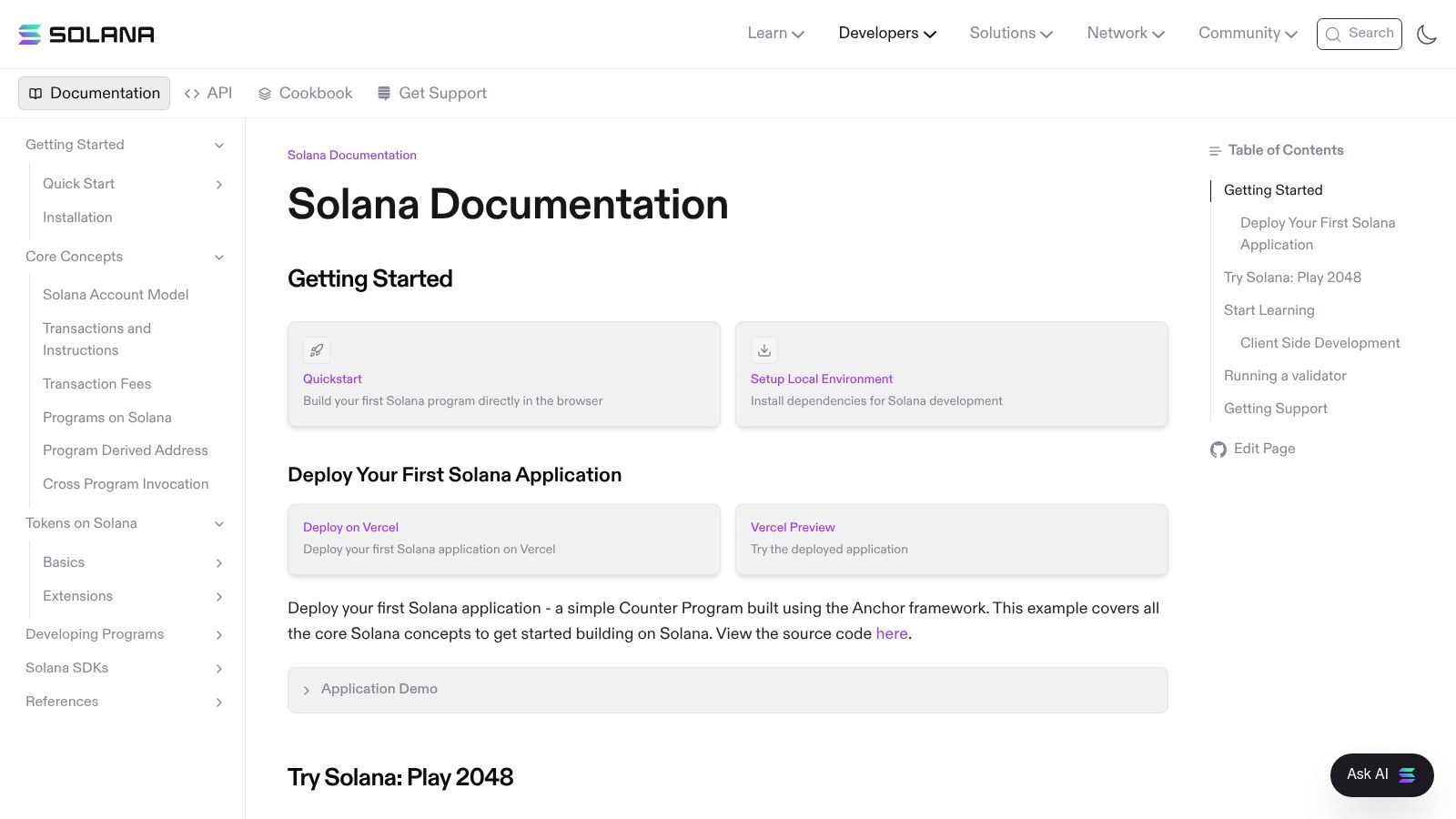
The documentation provides a direct pathway to building on Solana’s unique architecture, which includes features like Proof of History (PoH) and Sealevel for parallel transaction processing. This allows developers to create applications that can handle tens of thousands of transactions per second, a significant leap from the capacity of many EVM-based networks. For developers coming from other ecosystems, the documentation is the essential gateway to understanding and harnessing Solana's performance advantages.
Key Features and Developer Experience
The Solana Documentation is designed as a comprehensive, self-contained portal for developers. It’s not just a language reference but a full curriculum for building on the network, providing everything needed to go from concept to deployment.
- Architectural Deep Dives: Get in-depth explanations of core Solana concepts like accounts, programs (Solana's term for smart contracts), and the transaction processing model.
- Practical Tutorials: Follow step-by-step guides for setting up a local development environment, writing your first on-chain program in Rust, and deploying a full-stack dApp.
- Comprehensive References: Access detailed API references, command-line tool guides, and a rich library of example projects that demonstrate best practices.
While the documentation itself is text-heavy, its clarity and official authority make it invaluable. For developers looking to accelerate their build process, using an AI app generator like Dreamspace can help scaffold the project structure and front-end, allowing them to focus on mastering the complex Rust logic for their on-chain programs.
Key Insight: Solana’s choice of Rust is a strategic trade-off. It presents a steeper learning curve than Solidity but rewards developers with significant gains in performance and safety. Rust’s strict compiler and ownership model prevent entire classes of bugs at compile time, a critical feature for high-value financial applications.
Getting Started with Solana and Rust
Access to the Solana Documentation is completely free and open. The best starting point is the "Getting Started" section, which guides you through installing the necessary tools and setting up your local validator. While the documentation is extensive, a prerequisite is a solid understanding of Rust's fundamentals, particularly ownership, borrowing, and lifetimes. A common pitfall for new Solana developers is mismanaging account state and ownership, so it’s crucial to thoroughly study these concepts in the provided examples.
Website: https://docs.solana.com
5. GitHub: The Open-Source Hub for Blockchain Development
While not a language itself, GitHub is arguably one of the most critical platforms for anyone working with blockchain programming languages. It serves as the world's largest host for open-source code, making it an indispensable repository of real-world smart contracts, dApp frameworks, and core blockchain protocols. For developers, it is a living library where they can dissect the code behind major DeFi projects, study security best practices from audited contracts, and understand the practical application of languages like Solidity, Rust, and Go.
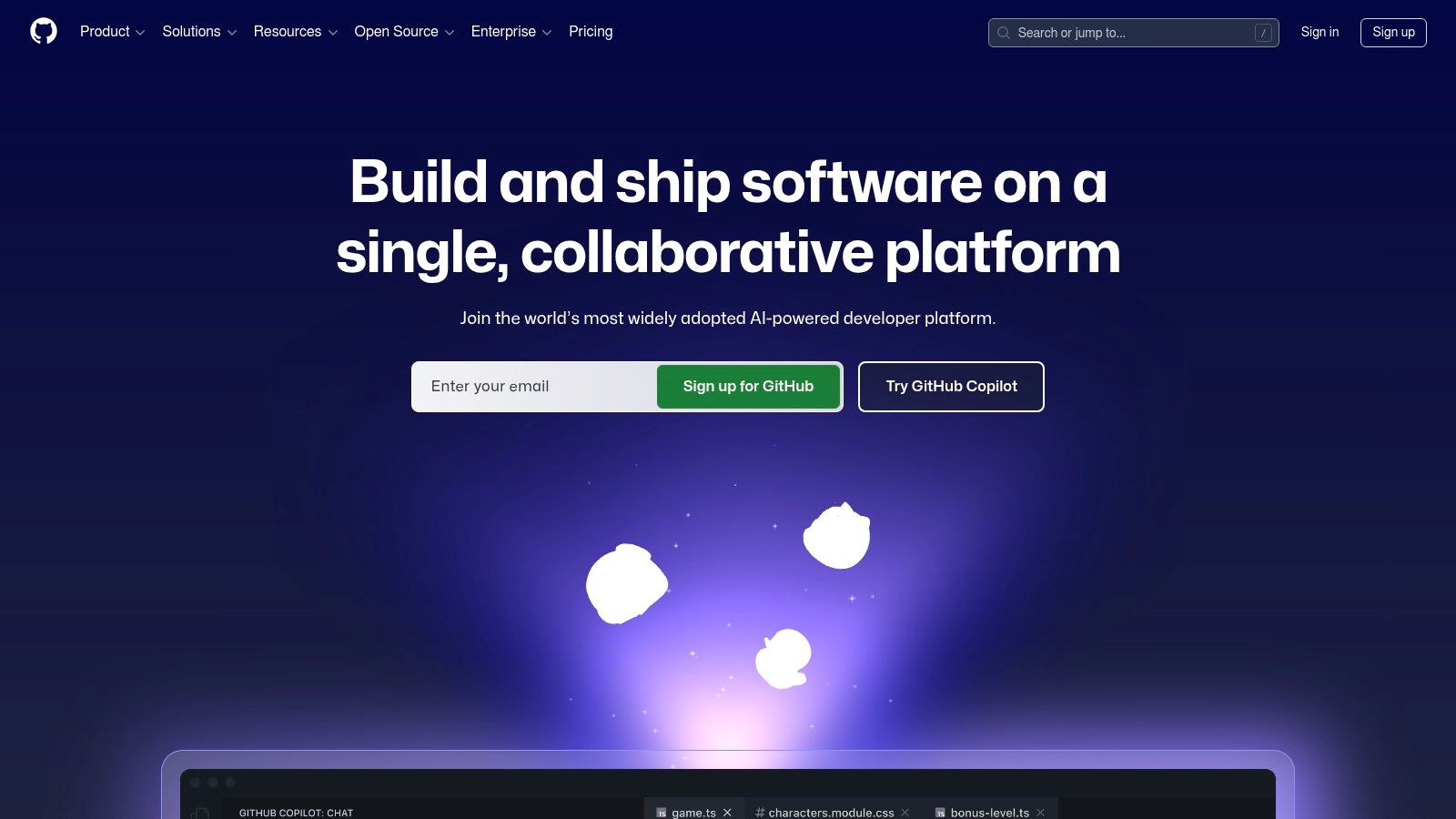
The platform’s power lies in its collaborative nature. It enables developers to not only view code but also contribute to active projects, report issues, and engage directly with the maintainers of foundational blockchain tools. This hands-on access transforms learning from a passive to an active experience, bridging the gap between theoretical knowledge and professional, production-grade development.
Key Features and Developer Experience
GitHub provides a complete suite of tools built around its core version control system, Git, which is essential for collaborative software development. This ecosystem empowers blockchain developers in several key ways:
- Access to Codebases: Developers can explore countless open-source blockchain projects, from standard contract libraries like OpenZeppelin to the source code of entire blockchains like Ethereum.
- Collaboration and Contribution: Features like pull requests, issues, and discussions allow for a seamless collaboration, enabling developers to suggest improvements, fix bugs, and become part of a global community.
- Version Control: Git integration provides a robust system for tracking changes, managing different versions of a dApp, and working in teams without conflicts.
For developers leveraging modern tools, understanding GitHub is non-negotiable. For instance, an AI app generator like Dreamspace often integrates with repositories to streamline the development and deployment pipeline, making familiarity with the platform crucial. This guide to building AI-powered apps offers more context on how these integrations work.
Key Insight: The true value of GitHub for a blockchain developer is learning from audited, battle-tested code. By studying successful projects, you can avoid common pitfalls and adopt security patterns that have been proven to withstand real-world attacks.
Getting Started with GitHub
Accessing and exploring public repositories on GitHub is completely free. To start, simply create an account and use the search bar to find topics like "Solidity smart contracts," "NFT marketplace," or "DAO." A common pitfall for newcomers is feeling overwhelmed; the best approach is to start small. Find a project that interests you, clone its repository, and try to run it locally. Reading through the code of well-documented projects is one of the fastest ways to improve your skills in any of the blockchain programming languages.
Website: https://github.com
6. Alchemy University: Your Free Gateway to Web3 Mastery
While not a language itself, Alchemy University is an indispensable educational platform for anyone serious about mastering blockchain programming languages. It offers free, structured, university-level courses designed to take developers from foundational knowledge to advanced Web3 engineering. By focusing on practical application and real-world projects, it provides a direct pathway to proficiency in languages like Solidity and JavaScript, which are essential for building on the blockchain. The curriculum is meticulously crafted to cover everything from smart contract fundamentals to the intricate details of blockchain infrastructure.
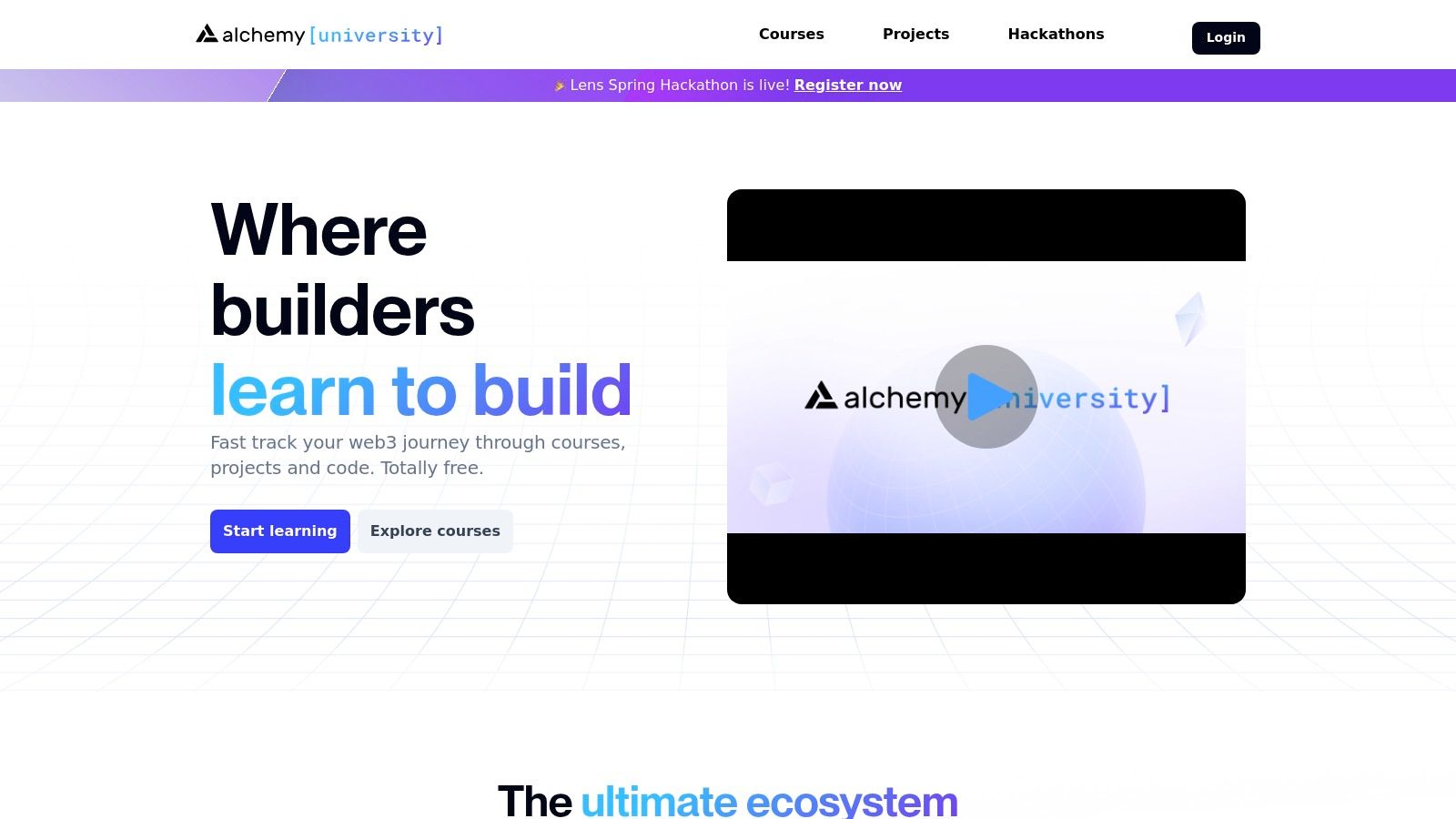
What makes Alchemy University exceptional is its hands-on approach. Learners don't just watch videos; they engage in coding challenges and build portfolio-worthy projects. This emphasis on practical skill development ensures that students not only understand the theory but can also apply it to create decentralized applications. The platform’s integration with Alchemy's suite of developer tools provides a seamless transition from learning to building on-chain.
Key Features and Developer Experience
Alchemy University stands out by providing an end-to-end learning experience that mirrors a real-world development environment. The platform is built to create job-ready Web3 developers.
- Comprehensive Curriculum: Its flagship "Ethereum Developer Bootcamp" covers Solidity, smart contracts, dApp architecture, and advanced topics like security and upgradability.
- Practical Coding Challenges: Every concept is reinforced with real coding exercises, ensuring you are actively writing and debugging blockchain code from day one.
- Free Access to Infrastructure: Students get access to Alchemy's powerful infrastructure, allowing them to test and deploy their smart contracts on testnets without any cost.
For developers looking to accelerate their dApp creation process, pairing the deep knowledge from Alchemy University with an AI app generator like Dreamspace can be incredibly effective. Dreamspace can handle the front-end scaffolding and boilerplate code, allowing developers to focus on implementing the complex smart contract logic they've mastered.
Key Insight: The true value of Alchemy University is its focus on the complete developer journey. It doesn't just teach a language; it teaches you how to be a blockchain developer, providing the theoretical knowledge, practical skills, and professional tools needed to succeed.
Getting Started with Alchemy University
Access to all of Alchemy University's educational materials is completely free. Prospective students simply need to sign up on their website to begin their learning journey. While the courses are comprehensive, having some prior programming experience, particularly with JavaScript, is highly recommended to get the most out of the curriculum. A common pitfall for self-learners is not building a portfolio; make sure to complete the projects and challenges to showcase your skills to potential employers.
Website: https://university.alchemy.com/
7. Moralis Academy
While not a language itself, Moralis Academy is an essential educational platform for anyone serious about mastering the most popular blockchain programming languages. It offers a structured, university-grade curriculum that transforms aspiring developers into skilled professionals. The platform provides in-depth courses covering languages like Solidity for Ethereum, Rust for Solana, and even the foundational principles behind Bitcoin's scripting language, making it a comprehensive resource for polyglot blockchain developers.
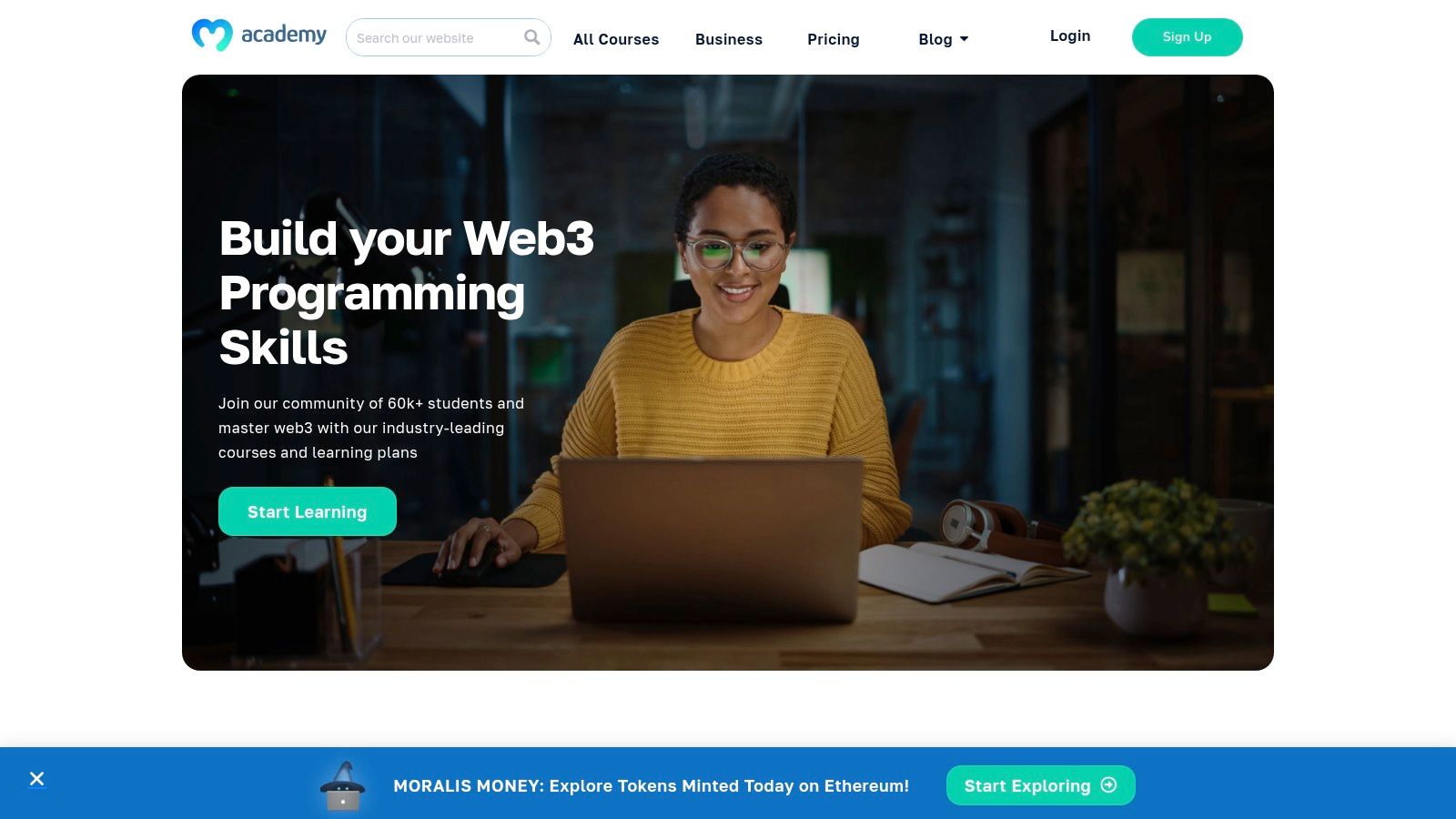
What sets Moralis Academy apart is its relentless focus on hands-on, project-based learning. Instead of just theoretical knowledge, students build real-world dApps, DeFi protocols, and NFT projects from scratch. This practical approach ensures developers not only understand the syntax of a language but also grasp the intricacies of deploying secure and efficient smart contracts on live networks. This commitment to practical application makes it an invaluable launchpad for a career in Web3.
Key Features and Developer Experience
Moralis Academy is designed as an all-in-one learning ecosystem, providing students with the tools and support needed to succeed in the fast-paced world of blockchain development.
- Diverse Curriculum: Courses span from beginner-friendly introductions to advanced topics across Ethereum, Solana, and Bitcoin development.
- Practical Projects: The curriculum emphasizes building a portfolio with real-world applications, a crucial asset for job seekers.
- Expert Instructors and Community: Learn from industry veterans and connect with thousands of fellow students and alumni in a vibrant developer community.
For developers looking to accelerate their workflow, the skills learned here can be powerfully combined with tools like Dreamspace. Using this AI app generator, you can quickly scaffold a project's front-end, allowing you to focus your expertise on the complex back-end logic taught in Moralis courses.
Key Insight: Moralis Academy's greatest strength is its ability to bridge the gap between knowing a language and being a proficient blockchain developer. The project-based learning and constantly updated content ensure your skills remain relevant and immediately applicable in the job market.
Getting Started with Moralis Academy
Access to Moralis Academy is based on a subscription model, with monthly and annual plans available that provide full access to all courses and community features. While this presents a cost barrier compared to free resources, the investment provides a structured and efficient learning path. New users should explore the platform's career tracks, which offer a guided journey from novice to specialist in areas like DeFi or smart contract development. A common pitfall for self-learners is information overload; the Academy's curated paths help prevent this by focusing your efforts on what matters most.
Website: https://academy.moralis.io/
Top 7 Blockchain Programming Language Resources Comparison
From Code to Creation: Your Next Steps in Blockchain Development
Navigating the landscape of blockchain programming languages can feel like the first major hurdle in your web3 journey. As we've explored, each language serves a distinct purpose, tailored to specific ecosystems and design philosophies. From Solidity's dominance in the Ethereum Virtual Machine (EVM) to Rust's performance-oriented approach for high-throughput chains like Solana, and Move's emphasis on formal verification for secure asset management, the choice you make will fundamentally shape your development experience and the capabilities of your dApp.
The journey from understanding syntax to deploying a functional smart contract is one of translation; you are translating a powerful idea into immutable, decentralized code. The key takeaway is that there is no single "best" language, only the "best fit" for your project's unique requirements.
How to Choose Your Path Forward
Selecting the right language requires a strategic assessment of your goals. Consider these critical factors before you commit to a learning path or development stack:
- Ecosystem and Platform: Where do you want to build? If your target is the vast, interconnected world of Ethereum and its Layer-2s, Solidity is your non-negotiable starting point. If you're drawn to the speed and low transaction costs of Solana, Rust will be your primary tool.
- Project Requirements: What is your application's core function? For a standard DeFi protocol or NFT project on an EVM chain, Solidity has a wealth of resources. For a high-frequency trading bot or a complex on-chain game requiring minimal latency, Rust is the superior choice.
- Security vs. Speed: What is your top priority? While all smart contract development demands a security-first mindset, languages like Move were built from the ground up with asset safety as the central design principle. This makes it an excellent candidate for applications where the risk of exploits must be minimized at all costs.
Turning Knowledge into Actionable Skills
Theoretical knowledge is only half the battle. True mastery comes from practical application and continuous learning. To accelerate your progress, focus on hands-on development and leverage modern tools that streamline complex processes. To further enhance your development process and learn efficiently, exploring the capabilities of free LLM tools can offer significant advantages by helping you generate boilerplate code, debug issues, and understand complex concepts faster.
Ultimately, the best blockchain programming languages are the ones that empower you to build. The decentralized future is not a spectator sport; it requires active participation and creation. Whether you are a vibe coder experimenting with new ideas, a seasoned developer transitioning into web3, or a crypto fan eager to contribute, the time to start is now. Pick your language, dive into the documentation, and begin building the next generation of the internet.
Ready to turn your blockchain concepts into reality without the steep learning curve? Dreamspace is a vibe coding studio and AI app generator that empowers you to build production-ready smart contracts and on-chain applications. Transform your vision into a tangible product and launch faster with the power of AI at Dreamspace.